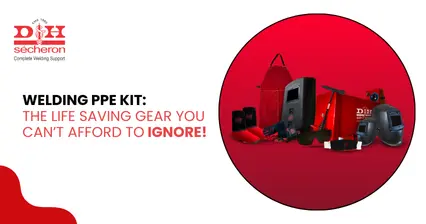SMAW welding tips: How to avoid common defects
SMAW (Shielded Metal Arc Welding) welding, also known as stick welding, is one of the most popular welding techniques used in the industry. It involves using a stick electrode to create an electric arc between the electrode and the metal being welded, creating a molten pool that cools and solidifies to create a strong, lasting bond.
Despite its popularity, SMAW welding comes with its own set of challenges. Weld defects can occur if the process is not carried out correctly. Here are some tips to avoid common defects in SMAW welding.
Metal preparation:
The first step in SMAW welding is preparing the metal you are going to weld. This involves cleaning the surface of the metal to remove any dirt, oil, rust, or other contaminants that can cause weld defects. You can use a wire brush, grinder, or other abrasive tools to clean the metal, but be careful not to remove too much material.
The next step is choosing the right thickness for the welding sheet/metal leaves for welding. A thin metal sheet can warp or buckle under the heat of the welding process, causing distortion or cracking in the weld whereas a thick metal sheet can prove difficult to achieve a strong, consistent weld.
Choosing the welding rod:
Different stick welding rods are designed for different types of metal and welding applications. Using the wrong rod can result in poor weld quality or weld defects.
For welding a high-strength steel use a stick welding rod that is specifically designed for that type of metal. For welding in a tight space or at an awkward angle use a smaller diameter rod that can reach into tight spaces and provide greater control.
Points to keep in mind while welding:
Now that the basics are taken care of, it's time to start welding. Here are some stick welding tips that will help you avoid common weld defects:
-
Use the right amperage setting for the stick welding rod you are using. If the amperage is too low, the electrode will not melt properly, resulting in poor penetration and weak welds. If the amperage is too high, the electrode will melt too quickly, causing splatter and porosity in the weld.
-
Maintain a consistent arc length between the electrode and the metal being welded. This will help you achieve a stable arc and consistent weld quality.
-
Move the electrode in a straight line along the joint being welded. Avoid making circular or back-and-forth motions, as this can create undercutting.
-
Keep the electrode at a 15-30 degree angle to the direction of the weld to get good penetration and to avoid creating a cold lap, where the metal is not properly fused together.
-
Use the right technique for the type of joint you are welding. For example, if you are welding a butt joint, you will need to weave the electrode back and forth to ensure full penetration. If you are welding a lap joint, you will need to use a push technique to avoid trapping slag in the weld.
At D&H Secheron, we offer a wide range of welding services, including SMAW welding. We're committed to providing our customers with the best possible products and services.
15 May 2025 | Welding
An In-Depth Exploration of Low-Alloy Steel: Your Comprehensive Guide
15 May 2025 | Welding
Nagpur - Bori - Tuljapur Road MSH-3 in Yavatmal District (Maharashtra)
15 May 2025 | Welding
Guidelines to Understand Gas Welding: Applications, Advantages & Disadvantages
15 May 2025 | Welding
3 Tips for Finding the Best Mild Steel Electrode for Your Application
15 May 2025 | Welding
How to Select the Right Welding Filler Wires for Stainless Steel Welding?
15 May 2025 | Welding
Building the Narendra Modi Stadium with Norma V and Autotherme-1 Electrodes
15 May 2025 | Welding
Low Alloy Steel Welding in a (PEB) Pre Engineered Building Structure
15 May 2025 | Welding
Welding Rods: Different Types and Tips for Properly Storing and Handling
15 May 2025 | Welding
Tips for Flawless Welds with Stainless Steel Electrodes: Pros and Cons
15 May 2025 | Welding
Exploring Applications and Benefits of Stainless Steel Welding Electrodes
15 May 2025 | Welding
Welding Basics: Joining Metals with Heat and Pressure - A Beginners Guide
15 May 2025 | Welding
Distinguishing Low-Alloy Steel from High-Alloy Steel: Understanding the Variations
15 May 2025 | Welding
Hard Facing Wire - Understanding the Process and Achieving Optimal Result
15 May 2025 | Welding
Exploring the Advantages of Stainless Steel Electrodes in Welding Applications
15 May 2025 | Welding
Weathering Steel vs. Traditional Steel: A Comparative Analysis of Performance
15 May 2025 | Welding
Choosing the Right Welding Rod: Why 6013 Electrodes Might Be Your Ideal Option
15 May 2025 | Welding
Why 7018 Electrodes Are Preferred for High-Strength Welds in Pipeline Construction
15 May 2025 | Welding
Filler Wire vs. Stainless Steel Filler Wire: Understanding the Key Differences
15 May 2025 | Welding
Exploring the Impact of Filler Material on Welding Quality and Durability
15 May 2025 | Welding
Choosing the Right Cast Iron Electrode for Different Welding Projects
15 May 2025 | Welding
Top Advantages of Cast Iron Electrodes for Industrial Welding Applications
15 May 2025 | Welding
Key Benefits and Challenges of Using TIG Welding in Industrial Projects
15 May 2025 | Welding
5 Reasons Why 7018 Electrode is the Gold Standard for Welding Professionals
15 May 2025 | Welding
Top 5 Advantages of Flux Cored Arc Welding for Heavy-Duty Applications.png)
15 May 2025 | Welding
Lotherme-601: A Game-Changer for Restoring Shoulder Pins in Heavy Machinery
15 May 2025 | Welding
How D&H Sécheron Helped Repair a Rotary Kiln’s Cooler Section with LoTherme 352
15 May 2025 | Welding
Piston Repair for Mining Industry: Cost-Effective Solutions with LoTherme 468.webp)






.jpg)








































.jpg)
.jpg)

.jpg)






.jpg)
.jpg)
.jpg)



.webp)
.jpg)
.jpg)
.webp)
.jpg)






















.png)



.webp)

.webp)
.webp)



